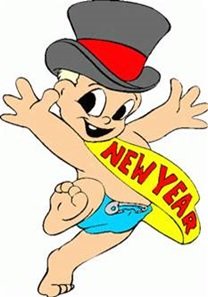 The dawning of
The dawning of  . It was really no different than any new year. But if you were involved in the pop music business – or a pop music radio listener – the year produced big changes. That’s when the Beatles stormed America. It was the beginning of a worldwide cultural phenomenon.
. It was really no different than any new year. But if you were involved in the pop music business – or a pop music radio listener – the year produced big changes. That’s when the Beatles stormed America. It was the beginning of a worldwide cultural phenomenon.

Beatlemania, and the British invasion that followed it, turned American pop music on its ear. And top 40 radio, still profiting from the lingering but lanquishing post-Presley surge, couldn’t get Beatles records on the air fast enough. It all started months – actually years – before John, Paul, George and Ringo became household names in the U.S. A ’62 and ‘63 sensation in Great Britain, the Beatles were delayed from earlier American stardom partly because of endless recording company squabbling over release, distribution and royalty issues. Additionally, some big-name American pop music leaders – including American Bandstand’s Dick Clark – were unsure America was ready for the Beatles (those mop-top hair-dos). When the Fab Four avalanche was unleashed, a lot of rock radio was caught by surprise. Many station music and program directors were riding playlists heavy with long-standing MOR and chicken rock material. But before long, both bootleg and bona fide copies of early Beatles songs were echoing all over the map.
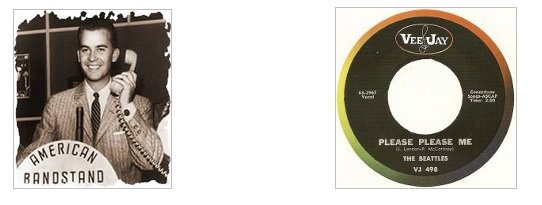
In February of ’63, Seattle’s KJR did give air play to the famous VeeJay release “Please Please Me.” But it never took off and would be 11 more months before Beatles explosion. (Pat O’Day claims KJR was first in the country to play the VeeJay recording.) VeeJay re-released the song to much greater success a year later.
Here’s an early ’64 KJR radio aircheck, before the Beatles lit up the airwaves. This is a previously unheard portion of a Mike Phillips’ aircheck from Jan. 11, ’64. It was just a few days before the Beatles “I Want to Hold Your Hand” began its rapid chart climb.
Aircheck – M. Phillips 4:38
Below is the KJR music survey at the time of Phillips’ aircheck. You’ll see “I want to Hold Your Hand” debuted at number 40. KJR charted the song at number 1 on Jan. 20, the same week the Beatles’ “She Loves You” debuted at number 12 — and a week before it jumped to number 2. The two songs were #1 and #2 on Billboard’s national Hot 100 in February and March, and again on Billboard’s year-end top 100. The Only other artist to claim the top 2 spots on Billboard’s best-of-the-year chart was Elvis Presley (“Don’t Be Cruel” and “Heartbreak Hotel”) in 1956.
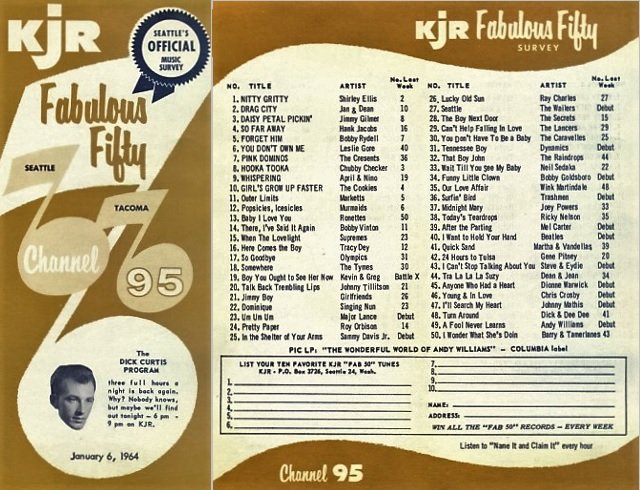
The KJR jock lineup in January of ‘64. All except Valley logged at least 5 years at KJR. Phillips, Roberts and O’Day did two stints at KJR each. Kay did three.
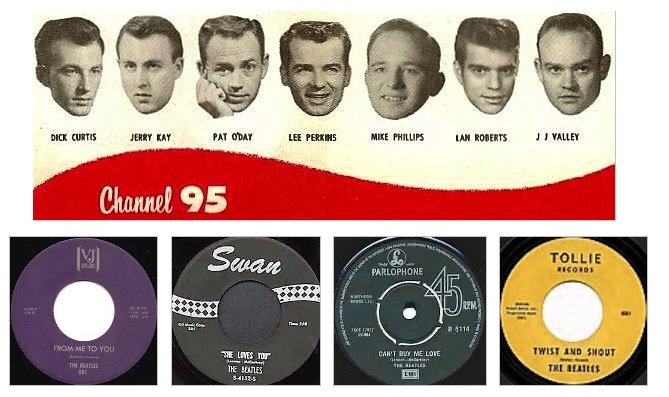
January of ’64 saw a slow take-off for the Beatles revolution because financial difficulties and legal haggling continued among a handful of record companies. Those which released early Beatles hits in Great Britain – VeeJay, Swan, Tollie and others – were losing the rights, sales and distribution battle with recording giant Capitol Records. In a show of stubbornness, Capitol refused four times to release Beatles songs in 1963.
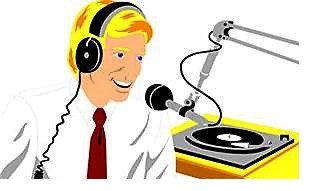
On the home front – like Seattle – other radio program and music directors joined O’Day (Les Williams and Ron Bailie, both at KOL), in clamoring for more Beatles. They’d nearly played the threads off the first two 45s. Except for tracks on albums released by VeeJay and Capitol (see below), it would be weeks before new single releases showed up on the radio or at local record outlets.
The chronology of events:
Sept. 16, ’63 – Swan Records releases “She Loves You,” mostly ignored at first but a huge hit 4 months later
Dec. 26, ’63 – Capitol Records starts release of “I Want to Hold Your Hand” (sells a million copies in 2 weeks)
Jan. 3, ’64 – A Beatles film clip shown on TV’s Jack Paar show (America’s first look at Beatles performing)
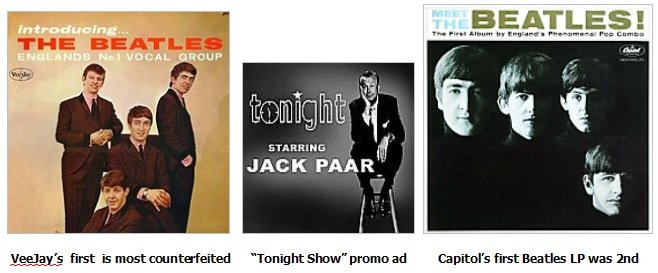
Jan 10 – After several delays VeeJay releases first Beatles album in U.S. “Introducing the Beatles.” Its huge sales potential was cut short by litigation from Capitol whose deeper legal pockets forced the financially-strapped company to agree to surrender rights to all its Beatles recordings. Before that happened the following October, VeeJay released more singles and “Introducing” became one of the most counterfeited records in history. The Fab Four’s magic had been uncorked. Network TV and other national news coverage grabbed the attention of more than just the kids playing the records. Plans were announced for the Beatles to visit the U.S. Folks in the states, including most hit radio broadcasters, were overwhelmed by the Beatles impact.
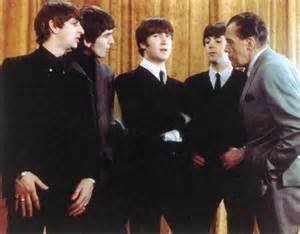 Jan. 20 – Capitol, now realizing the Beatles gold mine, chose not to wait until all the legal dust settled by releasing its first Beatles album “Meet the Beatles.” It was promoted as the group’s first and included the two smash hits “I Want to Hold Your Hand” and “She Loves You.” By mid-February it was the #1 album in America, a position it held for 11 weeks until replaced by “The Beatles Second Album.”
Jan. 20 – Capitol, now realizing the Beatles gold mine, chose not to wait until all the legal dust settled by releasing its first Beatles album “Meet the Beatles.” It was promoted as the group’s first and included the two smash hits “I Want to Hold Your Hand” and “She Loves You.” By mid-February it was the #1 album in America, a position it held for 11 weeks until replaced by “The Beatles Second Album.”
Jan. 30 – VeeJay re-releases single “Please Please Me” (B-side “From Me to You”) The record sells over 1 million copies.
Feb. 1 – Nationally, Capitol’s “I Want to Hold Your Hand” begins 7-week #1 run on Billboard Hot 100, holding Swan’s “She Loves You” at # 2 until Mar. 21 when it takes over #1 for two weeks. Again, broadcasting and music industry observers are amazed.
Feb. 7 – Beatles first trip to America, with more than 4,000 screaming fans greeting them at JFK Airport
 Feb. 9 – 73 million viewers see Beatles on Ed Sullivan Show. The group appears again on Sullivan (live) a week later (another 70-million watch) and again on tape on Feb. 23.
Feb. 9 – 73 million viewers see Beatles on Ed Sullivan Show. The group appears again on Sullivan (live) a week later (another 70-million watch) and again on tape on Feb. 23.
As more Beatles records were released in the U.S., four more songs broke the airwaves in February — another six in March and four more in April.
By spring, there was Beatles music all over the radio. What was believed to be a fad in January became a music phenomenon in April.
The group charted the top five songs on Billboard’s Hot 100 on April 4 (plus seven other songs) – an achievement never duplicated. A week later the Beatles owned 14 slots on Billboard’s Hot 100 (numbers 1, 2, 4, 7, 9, 14, 38, 48, 50, 52, 61, 74, 78 and 81), unparalleled command of America’s most heralded pop music barometer.
Beatles Hot 14 2:34
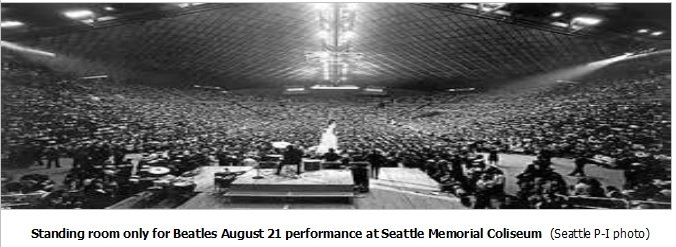

The Beatles Seattle performance hit the city like a bolt of lightning. Mr. KJR Pat O’Day recalls what it was like. Pat O’Day 1:44 (Courtesy of KPLU)
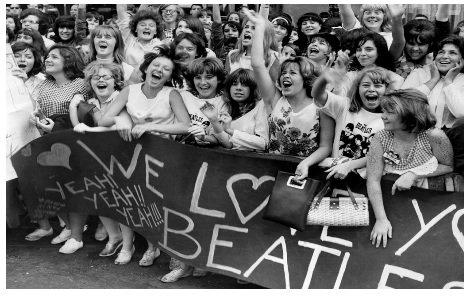 In 1964, the Beatles literally conquered the U.S. They nearly reached the top of the mountain in the same 15-week period their first smash hit was on the Billboard Hot 100. Their Aug.-Sept. North American Tour gave America notice of what was to come. They etched their place in history before completing two more American tours in 1965 and ’66. And their legacy was a lock by producing scores of other unforgettable songs (now American standards) before their 1970 breakup.
In 1964, the Beatles literally conquered the U.S. They nearly reached the top of the mountain in the same 15-week period their first smash hit was on the Billboard Hot 100. Their Aug.-Sept. North American Tour gave America notice of what was to come. They etched their place in history before completing two more American tours in 1965 and ’66. And their legacy was a lock by producing scores of other unforgettable songs (now American standards) before their 1970 breakup.
The ‘64 American debut year wasn’t the group’s most creative, but it was the most prolific after Capitol records finally released a large backlog of pre-’64 recordings which were entirely new to American audiences. In the following montage the Beatles held five positions in the top 25 songs of ’64. The countdown starts with #25. AUDIO> Top 25 of ’64 2:06
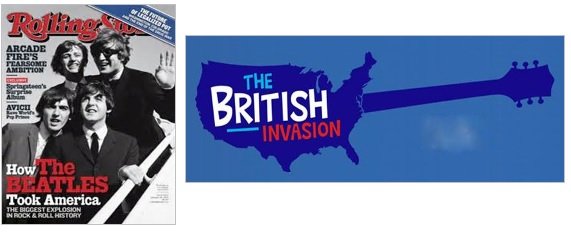
Top 25 of ’64 2:06
By the time 1964 was over, the Beatles introduced to millions of American music fans countless British Isles performers who at one time occupied about a third of this country’s pop music charts – from the national Billboard Hot 100 to the local top 40 in Dubuque. It all erupted from an incredible ‘64 jump-start that arguably led to the nation’s most exciting music revolution. It’s been said the Beatles not only changed music, they changed the world. – Ron DeHart
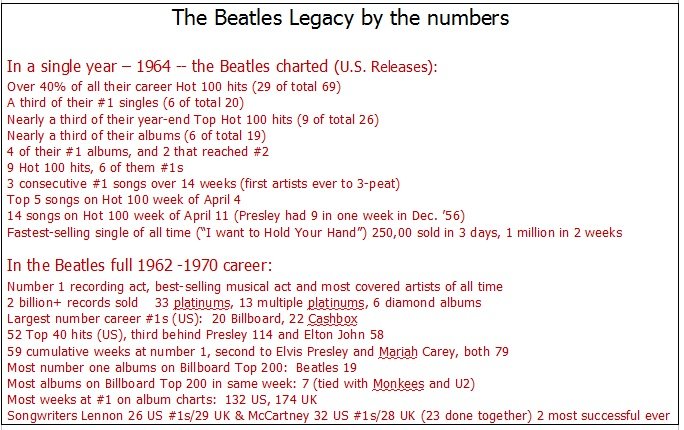

I am researching the first DJ to play a Beatles record in the U.S. and was wondering if anyone would have the exact date that KJR played the first Beatles record in February of 1963?
here is a KJR survey from JULY of 1963 with a BEATLES debut.
https://www.ebay.com/itm/114833139749
There are collectors of radio surveys, but I think that price is a little steep.